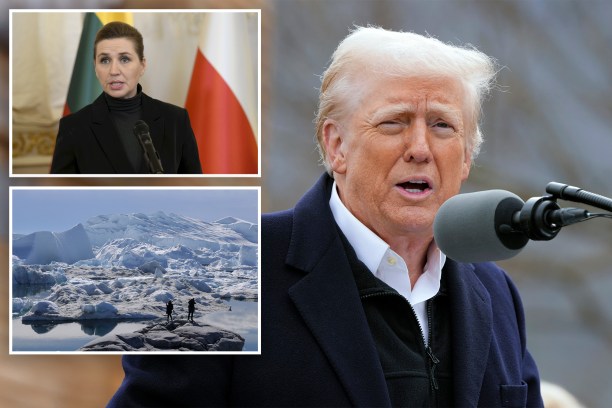Trump Conveys ‘serious’ and ‘firm’ Desire to Acquire Greenland in Call with Danish PM: ‘Danes now in crisis mode’; Greenland During Trump 2.0: Is America Poised for an Historic Arctic Territorial Expansion?
Trump conveys ‘serious’ and ‘firm’ desire to acquire Greenland in call with Danish PM: ‘Danes now in crisis mode’:
President Trump had a “firm” phone conversation with Denmark’s prime minister last week to convey his serious intentions of acquiring Greenland, according to a report citing officials privy to the talk.
Trump has been aggressive in his desire to make Greenland a US territory to bolster national security in the Arctic region — and has even refused to rule out using “military force” to get it.
The Danish government, which has ownership of the largest island in the world, has said Greenland is not for sale and will not be a part of the US.
Trump’s conversation with Danish PM Mette Fredericksen, in which he stood unwavering behind his intentions, did not go well, European sources familiar with the discussion told the Financial Times.
Another source said Trump “was very firm.
“It was a cold shower. Before, it was hard to take it seriously. But I do think it is serious, and potentially, very dangerous,” the person said.
A third source told the outlet, “The intent was very clear.
“[Trump officials] want it. The Danes are now in crisis mode.”
A fourth said, “The Danes are utterly freaked out by this.”
Trump’s team had previously relayed to The Post that the president was “100% serious” in his intentions on Greenland and also retaking the Panama Canal.
The president has said his interest in mineral-rich Greenland comes from needing “economic” and national security in the Arctic, as both Russia and China are gaining interests in the region. —>READ MORE HERE
Greenland During Trump 2.0: Is America Poised for an Historic Arctic Territorial Expansion?
It was just over five years ago, in August 2019, that President Trump first proposed purchasing Greenland from tiny Denmark, thereby completing a centuries-long project to expand and consolidate American power in the North American Arctic that began with the Alaska purchase in 1867, which ended Russia’s colonization of the far northwest of North America. Trump’s unsolicited offer made waves around the world as members of the diplomatic and national security community grappled with this sudden, unexpected prospect of an American Arctic territorial expansion, which would have been the first since 1867, when Secretary of State William H. Seward successfully engineered his vision for America to become a world power through successive expansions from the tropics to the polar region. Trump’s initial Greenland proposal was quickly and soundly rejected by both the Danes and Greenlanders, the latter famously responding, “We’re open for business, not for sale.” Most observers were just as pessimistic about William H. Seward’s nineteenth century Alaska purchase, which, like Trump’s 2019 proposal to purchase Greenland, was widely dismissed as “folly,” though it is now universally recognized for Seward’s strategic prescience. But all talk of a contemporary northern U.S. territorial expansion came to an end in 2020, with Trump’s second term delayed for another four years, as attention shifted from expanding America’s own sovereign Arctic footprint to expanding and fortifying the NATO alliance’s combined Arctic footprint in response to the geopolitical instability unleashed by Putin’s expansionist 2022 gambit in Ukraine.
However, with President Trump’s decisive electoral mandate late last year, and his return to power next week, America and the world are once again witnessing his unorthodox diplomatic vision for the Arctic, most evident in recent days with his renewed (and reinvigorated) calls for America’s Arctic expansion through gaining sovereign possession of Greenland. While criticism of Trump’s renewed overture to absorb Greenland, potentially by force or economic coercion if Denmark and Greenland continue to rebuff the President-elect, was immediate and near-unanimous (as was the case with his initial 2019 overture), this renewal of presidential interest in Greenland, never a given considering all of America’s diverse global strategic interests competing for presidential attention, does present Greenland with an historic opportunity to pursue its own agenda with the United States on matters relating to its future independence.
As with Trump’s rebuffed 2019 overture, both Greenland and its sovereign partner Denmark have again rejected all such talk as folly. Danish Prime Minister Mette Frederiksen reiterated on January 7th – the very day the President-elect’s son, Donald Trump Jr., flew to Nuuk on Trump Force One (as Trump’s famed 757 jet is known) for a quick but largely symbolic private visit, that once again, “Greenland is not for sale,” adding for good measure that “we need to stay calm and stick to our principles.”1) She noted that despite the President-elect’s overture, the United States remains Denmark’s “most important and closest ally,” and that she welcomed the President-elect’s interest in the Arctic, cautioning that it should “be done in a way that is respectful of the Greenlandic people. At the same time, it must be done in a way that allows Denmark and the United States to still cooperate in, among other things, NATO.”2)
Greenland’s Prime Minister, Múte Egede, continues to call for independence from Denmark, and for its liberation from a long colonial history, while Aaja Chemnitz, one of Greenland’s two representatives to Denmark’s parliament, told the press that “most people don’t want” to join the United States, particularly through an Alaska-purchase modeled acquisition: “I think some people find it quite disrespectful. And the way it has been done, and just the fact that you’re saying that you can buy another country.”3) But Trump, if anything, can be a persistent suitor when he sets his mind to it. Just ask the American electorate.
Geopolitical Logic in an American Arctic Expansion
A Greenland purchase, as improbable (and inappropriate to some) as it may seem, does have its own historical and geopolitical logic, as it would unify the northwestern and northeastern flanks of Arctic North America under the direct constitutional umbrella of the United States for the first time, bringing to an end one of the continent’s most persistent insecurities, which was last a central topic of strategic attention after Denmark fell to the Nazis and war came to the North Atlantic, with the defense of Greenland falling to the United States, as it would continue to do during the Cold War. The idea of purchasing Greenland was briefly floated in 1946 as America began to grapple with the new threat posed to North America by Soviet bombers. —>READ MORE HERE








Comments are closed.